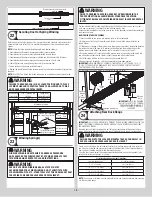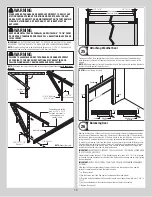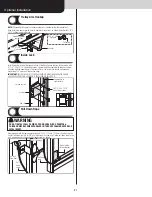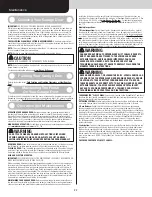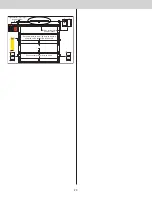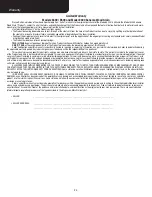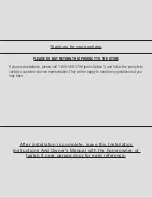
Draw horizontal chalk line prior to
winding
Spirals created after winding
Torsion spring
coils
Securing Door for Spring Winding
22
With the door in the fully closed position, place locking pliers onto both vertical tracks just
above the third track roller. This is to prevent the garage door from rising while winding
springs.
NOTE:
Check the following before attempting to wind torsion spring(s):
a. Counterbalance lift cables are secured at bottom corner brackets.
b. Counterbalance lift cables are routed unobstructed to cable drums.
c. Counterbalance lift cables are correctly installed and wound onto cable lift drums.
d. Counterbalance lift cables are taut and have equal tension on both sides.
e. Cable lift drums are against head plates and set screws are tight.
f. Torsion spring or springs are installed correctly.
g. Review the label attached to the spring warning tag, to determine number of spring turns
required.
NOTE:
Door MUST be closed and locked when winding or making any adjustments to the
torsion spring(s).
WARNING
FAILURE TO ENSURE DOOR IS IN A CLOSED POSITION AND TO PLACE
LOCKING PLIERS ONTO VERTICAL TRACK CAN ALLOW DOOR TO RISE
AND CAUSE SEVERE OR FATAL INJURY.
Winding Bars
(Steel Rods)
Size Of Winding Bar
(Inches)
Spring Inner
Diameter Used On
1/2” dia. x 18”
5/8” dia. x 24”
2” and 2-5/8”
3-3/4”
Locking pliers above
third track roller on
both sides of door
Bottom section
Lock
section
Locking pliers attached
to crown leg of vertical
track
Intermediate section
Vertical
track
Vertical
track
Winding Spring(s)
23
WARNING
WINDING SPRING IS AN EXTREMELY DANGEROUS PROCEDURE
AND SHOULD BE PERFORMED ONLY BY A TRAINED DOOR SYSTEM
TECHNICIAN USING PROPER TOOLS AND INSTRUCTIONS.
WARNING
USE ONLY SPECIFIED WINDING BARS, AS STATED IN STEP
SECURING DOOR FOR SPRING WINDING. DO NOT SUBSTITUTE WITH
SCREWDRIVERS, PIPE, ETC. OTHER TOOLS MAY FAIL OR RELEASE FROM
THE SPRING CONE AND CAUSE SEVERE OR FATAL INJURY.
WARNING
PRIOR TO WINDING THE SPRING, ENSURE YOU’RE WINDING IN THE
PROPER DIRECTION AS SHOWN BELOW. OTHERWISE THE SPRING
FITTING MAY RELEASE FROM SPRING AND RESULT IN SEVERE OR FATAL
INJURY.
Position a ladder slightly to the side of the spring so that the winding cone is easily acces-
sible, and so your body is not directly in line with the winding bars.
Check the label attached to the spring warning tag for the required number of complete turns
to balance your door.
HOW TO WIND TORSION SPRINGS:
1. Insert one winding rod snugly into winding cone, to full socket depth
2. Maintaining a tight grip on the winding rod rotate it slowly in the proper direction, as
shown below.
3. If there is any slippage of the winding rod in the winding cone socket, reverse the direction
of winding and return the cone to its original position. Remove the winding rod from the
winding cone socket. Reseat the winding rod in the socket. Start over at Step #1.
4. When the winding rod is vertical above the winding cone, insert another winding rod into
one of the other sockets, being careful to seat it snugly and at full socket depth.
5. Hold the spring with the second winding bar, and remove the first.
6. Repeat Steps #2 through #5 until the complete turns have been applied.
IMPORTANT:
AFTER WINDING THE SPRING(S), TIGHTEN THE (2) SET SCREWS TO 14-15
FT. LBS. OF TORQUE IN THE WINDING CONE. ONCE SET SCREWS CONTACT THE SHAFT,
TIGHTEN SCREWS ONE FULL TURN.
HIGH SPRING TENSION CAN CAUSE
SERIOUS INJURY OR DEATH.
DO NOT
adjust, repair or remove springs or parts to
which springs are connected, such as steel brack-
ets, cables, wood blocks, fasteners or other parts of
the counterbalance system.
Adjustments or repairs must
ONLY
be made by a
trained door systems technician using proper tools
and instructions.
DO NOT
remove, cover or paint over this tag. Prod-
uct user should inspect this tag periodically for
legibility and should order a replacement tag from
the door manufacturer, as needed.
©Copyright 2010 Overhead Door Corporation
102081 REV2 06/24/2010
HIGH SPRING TENSION CAN CAUSE
SERIOUS INJURY OR DEATH.
DO NOT
adjust, repair or remove springs or parts to
which springs are connected, such as steel brack-
ets, cables, wood blocks, fasteners or other parts of
the counterbalance system.
Adjustments or repairs must
ONLY
be made by a
trained door systems technician using proper tools
and instructions.
DO NOT
remove, cover or paint over this tag. Prod-
uct user should inspect this tag periodically for
legibility and should order a replacement tag from
the door manufacturer, as needed.
©Copyright 2010 Overhead Door Corporation
102081 REV2 06/24/2010
Torsion shaft
Winding
cone
Torsion
spring(s)
Approved
winding
rod
Set screws
IMPORTANT:
CHECK THE WARNING
TAG(S) ATTACHED TO THE SPRING(S)
FOR THE REQUIRED NUMBER OF
COMPLETE TURNS, TO BALANCE
YOUR DOOR.
Warning
tag(s)
Approved winding rod
Torsion spring(s) should be wound in the direction the end coil points.
Spring
coils
Attaching Rear Back Hangs
24
IMPORTANT:
HOLD THE DOOR DOWN TO PREVENT IT FROM RISING UNEXPECTEDLY IN THE
EVENT THE SPRING(S) WERE OVER-WOUND AND CAUTIOUSLY REMOVE LOCKING PLIERS
FROM VERTICAL TRACKS.
Raise the door until the top section and half of the next section are in the horizontal track
radius. Do not raise door any further since rear of horizontal tracks are not yet supported.
WARNING
RAISING DOOR INTO THE LOOSE HORIZONTAL TRACKS CAN RESULT IN
DOOR FALLING AND CAUSE SEVERE OR FATAL INJURY.
Clamp a pair of locking pliers onto the vertical tracks just above the second track roller on
one side, and just below the second track roller on the other side. This will prevent the door
from raising or lowering while installing the rear back hangs.
Using the chart below, select the appropriate perforated angle (may not be supplied). Fabri-
cate and install rear back hangs, as shown.
Perforated Angle Gauge Weight Limitations:
Perforated Angle Gauge
Door Balance Weight
2” x 2” x 12 Gauge
Less Than 800 lbs.
1-1/4” x 1-1/4” x 13 Gauge
Less Than 305 lbs.
1-1/4” x 1-1/4” x 15 Gauge
Less Than 220 lbs.
1-1/4” x 1-1/4” x 16 Gauge
Less Than 175 lbs.
NOTE:
If an opener is installed, position horizontal tracks one hole above level when securing
it to the rear back hangs.
18
Summary of Contents for 8300
Page 25: ......















